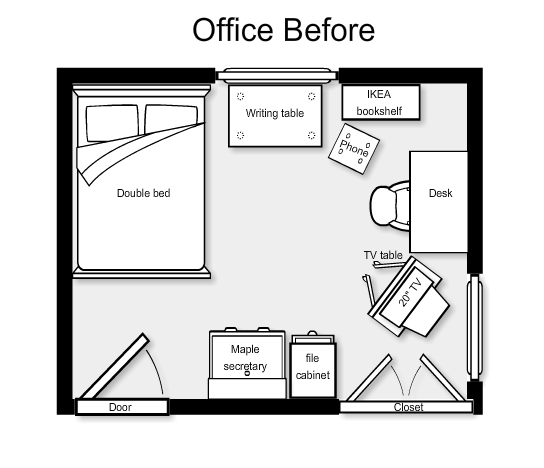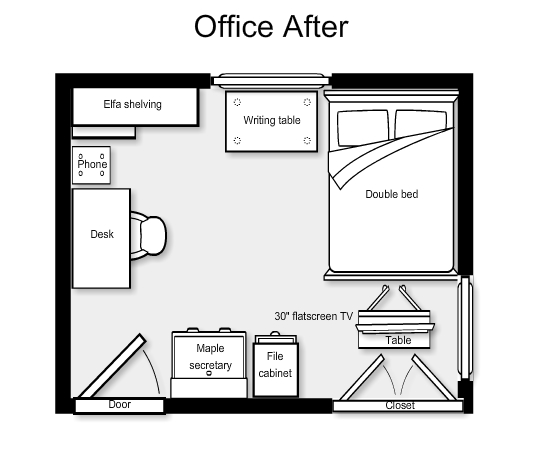Last year, I decided to re-do my home office. I knew what worked and didn’t work in my current set up and what my limitations were.
My primary limitation was the size of the room. It is tiny, barely 10’ x 12’ and also doubles as a guest room.
The first step was to make a floor plan.
- Measure the room. Draw the general shape of the room on a sheet of paper and include the doors, windows, electrical outlets. Start measuring. Use a good, 15 or 20 foot metal tape measure and measure to the half inch. Measure the length of the walls, then measure how far from the corners the doors, windows, electrical outlets are. Measure the width of the doors and windows, including molding. Add up the partial measurements to make sure the total length matches the actual length of the wall. Measure the height of the walls and the distance from the floor to the bottom of each window frame.
- Measure your furniture. Draw rough diagrams of each piece of furniture in the room and write the dimensions along the appropriate side. Don’t forget the height for pieces that might sit under windows.
- Make the plan. I used Icovia , an online tool that allows you to easily create and save floor plans. It has symbols for most pieces of furniture and accessory items you will encounter, including electrical outlets. Enter the dimensions you measured for the room, find the icons for furniture and do the same and you’ll have a plan.
- Move things around. You can move items around easily, changing their orientation, until you come up with a floorplan you like and everything fits. Be sure to leave enough clearance behind the desk for an office chair (about 36”), and allow room for drawers to open fully.
- New furniture. If you need a new piece of furniture, you now know how big or small it must be. I decided to replace my Ikea bookshelf with a floor to ceiling shelving system attached to the wall.
Here’s what my office floor plan looked like before.
I essentially created a mirror image of the original floor plan. I moved the desk so that I faced the door and moved the phone table against the wall.
By moving the bed, I opened up the entrance to the room, making it appear more spacious, and improving its feng shui.
The writing table stayed in front of the window because I like to look at my garden when I get mentally stuck.
Now, when I work at my desk I have plenty of natural light and feel more connected to the house.
Next: Creating the Visual Environment

2 responses to “Home Office Makeover: How to Make a Floor Plan”
Great tip on the Icovia site. Very easy to make a quick floor plan online.
This is totally cool! I love the way you explained the problem, structured the solution, and explained how it worked.